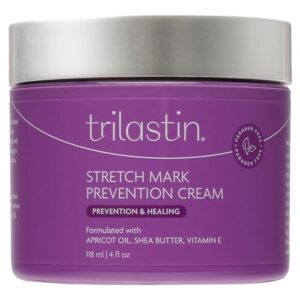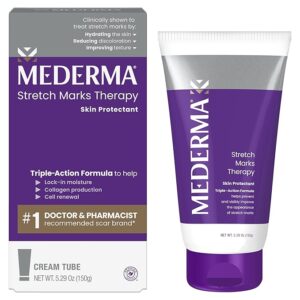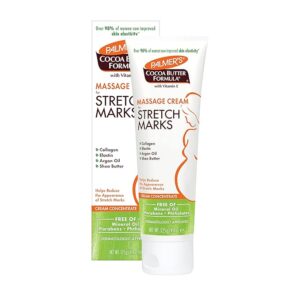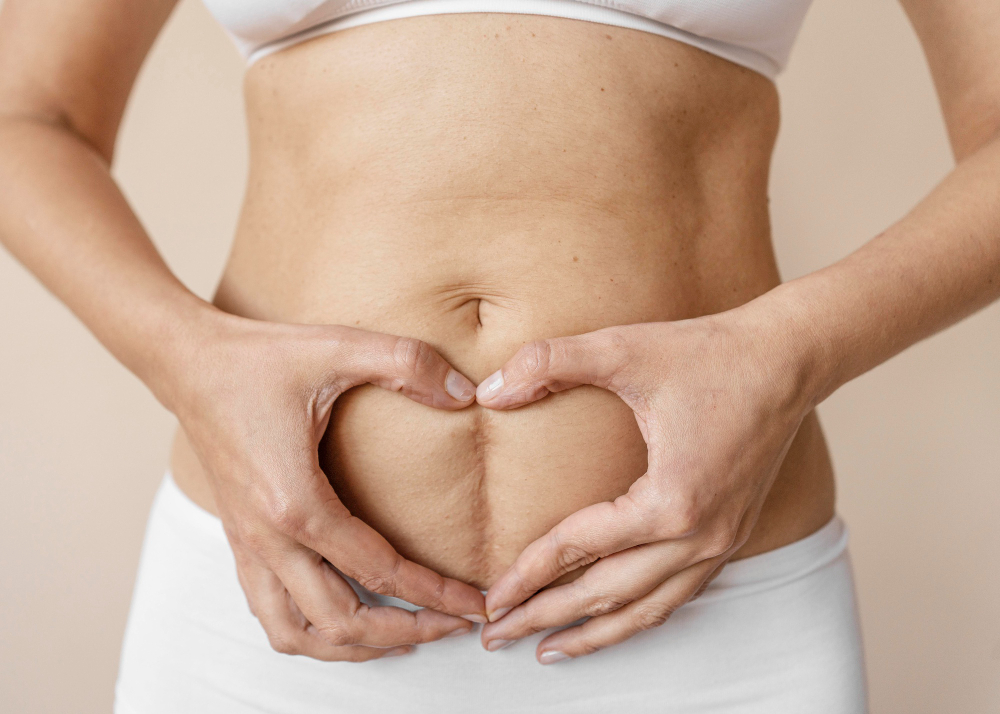/IN THIS ARTICLE
♦ PART A
♥ 7 Tips to Help Prevent Stretch Marks
♥ How to Prevent and Minimize Stretch Marks During Pregnancy
♥ Why Do Stretch Marks Happen During Pregnancy?
♥ Who’s More Prone to Stretch Marks?
♥ Common Areas for Stretch Marks
♥ How to Prevent and Minimize Stretch Marks
♥ Postpartum Recovery: Why It Matters
♥ In Summary
♥ Best stretch mark creams
♥ FAQ
7 Tips to Help Prevent Stretch Marks
Those indented streaks you may see on your skin, mostly red, purple, or silver in color, are stretch marks. They just seem to love appearing on the stomach, chest, hips, bottom, and thighs.
Though they are a common sight during pregnancy, anyone can get them at any stage of life. If your mom, dad, grandparents, or other blood relatives have stretch marks, then you are more likely to see them on your skin too.
Even if you’re prone to stretch marks, there are things you can do to reduce your chances of getting them and to treat the ones you already have.
1. Take Control of Your Weight
- Whether you’re pregnant or not, one of the best ways to avoid stretch marks is to be at a healthy weight. These marks show up when you gain weight quickly and your skin stretches quickly. They can also show up after weight loss. Stretch mark can also come from big muscle gains from working out or from puberty growth spurts.
- Avoid drastic changes in your body size. To control your weight stick to a regular exercise routine and a balanced diet. See your doctor to figure out why you’re experiencing sudden weight changes.
2. Stay Hydrated
- Stretch marks can be avoided by keeping your skin moisturized and plump with water.
- According to the Institute of Medicine, men should aim for 104 ounces of water daily, women should aim for 72 ounces.
- Caffeinated drinks like coffee can increase your risk of getting stretch mark, so balance your caffeine intake with lots of water, herbal teas and other non-caffeinated fluids.
3. Eat a Nutrient Rich Diet
- Stretch mark can be caused by a nutrient deficient diet. To improve your skin health eat foods high in:
- Vitamin C
- D-vitamin
- Vitamin E
- Zinc Protein
- Include a range of vibrant, unrefined foods in your diet. A rainbow of nutrients can be found in a meal consisting of eggs, whole wheat bread, and mixed berries.
4. Eat Foods High in Vitamin C
- Having strong and elastic skin is key to minimizing wrinkles and maybe stretch marks. Collagen plays a big role in this. Collagen synthesis depends on vitamin C. Fruits and veggies especially citrus fruits like oranges and lemons are a good source of it.
5. Take a Vitamin D Supplement
- Stretch marks and low vitamin D levels may be linked, research suggests. Maintaining proper vitamin D levels may help, more research is needed. The easiest way to get your daily dose of vitamin D is through sun exposure. Fortified foods like bread, cereal and dairy products also have it.
6. Eat Zinc Rich Foods
- Zinc helps in wound healing and reduces inflammation so it’s good for the skin. Stretch mark and zinc are not strongly related but eating foods high in zinc like nuts and fish can help maintain good skin.
7. Treat new stretch mark as soon as they appear
- Stretch marks are impossible to avoid totally but you can try to minimize their visibility. For guidance on how to manage new stretch marks consult a doctor or dermatologist. For new marks they can recommend the best treatment and help you identify the cause.
In the end, although stretch marks is a part of life you can manage and minimize their presence by living a healthy lifestyle with proper diet and hydration and proactive treatment.
How to Prevent and Minimize Stretch Marks During Pregnancy
Pregnancy is a great journey, but let’s be sincere—it’s not all glowing pores and skin and lovely child bumps. For many mothers-to-be, the truth also includes stretch marks. These traces can leave you feeling a touch less confident, despite the fact that they’re a very herbal part of being pregnant. If you’ve been questioning a way to keep the pesky marks at bay—or at the least minimize them—you’re in the right region.
Let’s dive into why stretch marks take place, who’s much more likely to get them, and some realistic hints to save you or lessen their appearance.
Why Do Stretch Marks Happen During Pregnancy?
Stretch marks, additionally referred to as striae gravidarum, are thin, streaky strains that show up on the skin when it’s stretched too quickly. During pregnancy, your stomach, hips, thighs, and different regions become bigger as your baby grows. If your pores and skin can’t keep up, the underlying elastic and collagen fibers can tear, causing those purple, purple, or maybe purple lines.
Here’s what takes place in tiers:
- Early days: Right after transport, stretch marks are typically crimson or purplish and really significant.
- Three months postpartum: Your skin starts to get better, and the marks might also fade to a lighter color.
- Six months postpartum: Most stretch marks lose their color and flip silvery or white, leaving faint scar-like strains.
Not simply moms-to-be, each person experiencing speedy weight adjustments—like teens throughout growth spurts—can get stretch marks. But in pregnancy, they’re lots greater not unusual due to speedy weight gain and skin stretching.
Who’s More Prone to Stretch Marks?
Stretch marks can appear to anyone, however a few humans are much more likely to enjoy them than others. Here’s a quick tick list of things that grow your chances:
- Rapid weight benefit: Gaining weight too quickly can overstretch your skin.
- Dry skin: Without the right hydration, skin is less elastic and more at risk of damage.
- Inactive way of life: Lack of exercise can result in higher fat storage, which contributes to stretch marks.
- Minimal skincare ordinary: Neglecting moisturizing and restoration care can leave your pores and skin more susceptible.
Common Areas for Stretch Marks
Stretch marks can appear almost everywhere, and your pores and skin stretch rapidly. During pregnancy, the most not unusual areas encompass:
- Belly: The maximum apparent spot. As your infant grows, so does your tummy, making it a top target for stretch marks.
- Breasts: As your body preps for breastfeeding, your breasts can also make bigger, main to vertical traces.
- Thighs and buttocks: These regions regularly store more fat, which can stretch the skin.
- Hips: Rapid weight advantage can leave marks right here, too.
How to Prevent and Minimize Stretch Marks
While you won’t be able to avoid them totally, there are numerous steps you could take to reduce the probabilities of stretch marks—or at the least decrease their severity.
1. Use an Abdominal Support Belt
Starting in the early levels of pregnancy, take into account sporting a belly help belt. This can help take some stress off your growing stomach and decrease the pressure on your skin. However, keep away from sporting it during the last month to ensure it doesn’t interfere with your infant’s positioning.
2. Control Weight Gain
It’s more difficult for your skin to keep up the faster you gain weight. Aim for a gradual, healthy weight gain of eleven. weighing between 11.5 and 13.5 kg (25–30 kg) while pregnant. Adhere to a well-rounded weight loss regimen that includes plenty of fruits, vegetables, lean meats, and whole grains. Incorporate mild physical games like prenatal yoga or swimming to hold a wholesome weight.
3. Moisturize and Hydrate Your Skin
Dry pores and skin is a recipe for stretch marks. Start moisturizing the instant you discover you’re pregnant. Focus on your stomach, thighs, breasts, and buttocks—apply a hydrating lotion or cream 2-three instances an afternoon.
Pro Tip: For better absorption, wash your skin with water before using a moisturizer. Additionally, remember to use sunscreen! Keep your skin and pores covered when you’re out because UV exposure can exacerbate stretch marks.
4. Massage Regularly
After each shower, treat your pores and skin to a mild rub down with a nourishing oil, like olive oil or coconut oil. Massaging improves blood movement, boosts elasticity, and may help reduce the advent of existing marks.
Here’s how to do it:
- Chest: Massage gently from the center outward.
- Belly: Use round, clockwise motions around your navel.
- Thighs and buttocks: Move upward in lengthy, gentle strokes.
Important Note: If you’re vulnerable to miscarriage or have any pregnancy complications, skip the rub down.
5. Exercise Moderately
Light exercises like swimming and yoga now not only help manage your weight but also improve skin elasticity. Swimming, in particular, is brilliant—it strengthens muscles and enables you to exercise deep respiration, which can be a lifesaver at some point in labor.
Postpartum Recovery: Why It Matters
Once your infant is right here, it’s time to focus on restoration. Losing pregnancy weight gradually can help your pores and skin regain some of its elasticity, making stretch marks less visible. Keep up with your moisturizing and rubdown habits even after shipping to offer your skin the pleasant hazard to get better.
While stretch marks can also fade through the years, they hardly ever disappear completely. But that’s okay—they’re a herbal part of your journey into motherhood. The secret is to save them as a good deal as possible by controlling weight advantage and prioritizing pores and skin care properly from the start.
In Summary
Stretch marks may seem like an unwelcome visitor during being pregnant, however, with the proper care, you can lessen their impact. Keep your pores and skin hydrated, control your weight, and include ordinary massage to give your pores and skin an excellent shot at staying clean. Remember, each stretch mark tells a tale—a beautiful reminder of the tremendous life your body is creating.
Let’s make that journey as snug as possible!
Best stretch mark creams:-
1. TriLASTIN Maternity Stretch Mark Prevention Cream

SHOP NOW: $42 AT AMAZON
2. Mederma Stretch Marks Therapy

SHOP NOW: $29 AT AMAZON
3. Bio-Oil Skincare Body Oil, Vitamin E, Serum for Scars & Stretchmarks

SHOP NOW: $11 AT AMAZON
4. Body Boost Milk & Honey Stretch Mark Butter

SHOP NOW: $16.99 AT AMAZON
5. Palmer’s Cocoa Butter Formula

SHOP NOW: $14AT AMAZON
FAQ:-
1. What are the only substances inside the fine stretch mark creams?
- Retinol, hyaluronic acid, and peptides: These sell collagen production and improve skin elasticity, decreasing the appearance of stretch marks.
- Natural oils and nutrients (e.g., shea butter, cocoa butter, vitamin E): These moisturize deeply and beautify skin restoration.
2 Which stretch mark lotions are safe to apply for the duration of being pregnant?
- Look for retinol-unfastened lotions with substances like cocoa butter, shea butter, or nutrition E.
- Popular pregnancy-secure alternatives encompass Bio-Oil, Palmer’s Cocoa Butter Formula, and Earth Mama Belly Butter.
3. What is the difference between stretch mark creams and stretch mark oils?
- Creams are thicker, presenting hydration and vitamins for long intervals.
- Oils soak up quickly and are perfect for rubdown however would possibly lack positive energetic ingredients.
Also Read This Article: How to Get Start Vegan Skincare



Leave a Reply